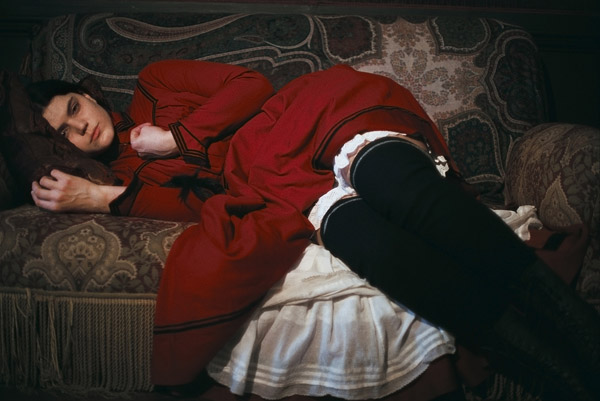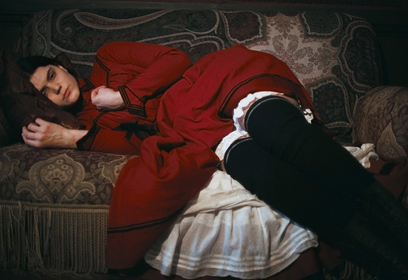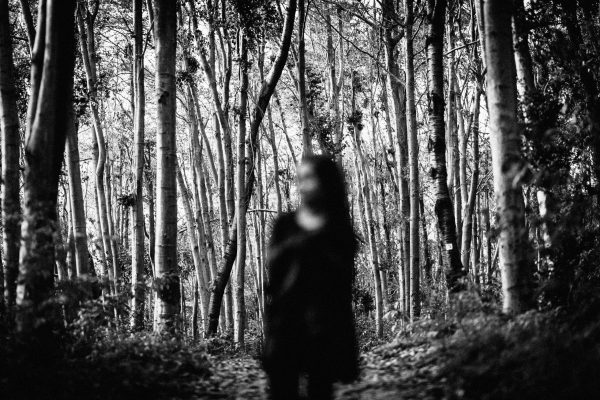
The French singer and actress Soko, as Augustine in Alice Winocour’s Augustine.
Augustine
directed by Alice Winocour
Music Box Films
Augustine, the first feature film from the French auteur Alice Winocour, premiered at Cannes during La Semaine de la Critique, the week of screenings meant to encourage new filmmakers. The film was warmly received and subsequently earned a coveted César nomination for best first film. Most American film critics also praised it as a polished cinematic jewel with a welcome feminist perspective that exposed the greatest French physician of the 19th century variously as a charlatan, a misogynist, and a sadist who violated his Hippocratic oath in order to have sex with a teenage patient. Indeed it is a beautiful movie, but for those who know something about the history on which it is supposedly based, its flaws are painfully obvious and deeply troubling.
The film, a costume drama set in the 19th century’s Belle Époque, claims to tell the story of the relationship between the preeminent clinician of that era, Jean-Martin Charcot (Vincent Lindon), and his hysterical patient, the kitchen maid Augustine (Soko). In Winocour’s screenplay, and in the mantra of the film’s marketing campaign, Augustine is transformed from “subject of study to object of desire.” American filmgoers will see it as the French prequel to David Cronenberg’s A Dangerous Method (2011), about Carl Jung’s unethical and sadomasochistic affair with his psychoanalytic patient Sabina Spielrein. That screenplay was based on Spielrein’s papers and on substantial documentation; Jung was a notorious repeat offender.
Winocour knows virtually nothing about the actual relationship between Charcot and Augustine, if indeed there was ever was one. She made the doctor-patient story up out of whole cloth.
Charcot was in fact famously remote from the patients at Salpêtrière Asylum, over which he presided. His assistant, Dr. D.M. Bourneville, was responsible for Augustine’s care and compiled her history. Neither doctor psychoanalyzed Augustine, and the dangerous method that promotes feelings of intimacy (transference and counter-transference) would be invented by Freud 30 years later. Freud, who studied with Charcot but not during the years when Augustine was a patient, so admired the “Napoleon of the neuroses” that he named his eldest son Jean Martin after Charcot.
Winocour not only invented the erotic relation between Charcot and Augustine, but she also misrepresented the unfortunate young woman’s history. We know that when she first entered the Salpêtrière with her “hysterical symptoms,” Augustine was only fourteen or fifteen years old and had been brutally sexually abused. Winocour’s Augustine is a surprisingly self-confident nineteen-year-old woman who suffers from hysterical fits, but has no psychological past.
In early interviews Winocour was at some pains to explain how she had created her screenplay. She had done some reading about Charcot and the Salpêtrière. She learned about his research on hysteria, a mysterious illness that at the time doctors thought afflicted only women, and the famous Tuesday clinics at which patients were presented to doctors from around the world and to interested Parisians as well. Charcot had reintroduced hypnosis as a diagnostic and clinical tool, and hysterical patients would be hypnotized so that audiences at his Tuesday clinics could witness the natural course of hysterical seizures. Charcot’s most famous hysterical patient—Marie Wittman, known as Blanche—is the woman portrayed in André Brouillet’s great painting Une Leçon de Charcot à la Salpêtrière. Much had been written about Charcot and his hysterics whose seizures often had sexual overtones. But Winocour was looking for her own way into this material. She read in the Salpêtrière’s records that Augustine had escaped from the hospital dressed in a man’s clothes; Winocour saw this as a woman liberating herself. But what really intrigued her was that in all the hospital records there was nothing about the doctor-patient relationships. She decided to fill in that void from her imagination.
Winocour imagines Charcot as a fascinated little boy, aroused and frightened.
Winocour was not the first to exploit Augustine for her own purposes. Augustine was featured in Iconographie Photographique de la Salpêtrière, a published visual record of hysterical patients’ disorders assembled by Bourneville and Paul-Marie-Léon Regnard. (The Iconographie can be found in a digital version on the Web.) By modern ethical standards, such a publication is unacceptable, and there is no reason to believe that Augustine was given the opportunity to refuse this violation of her privacy. Charcot was no doubt complicit in this; he was one of the first clinicians to make systematic use of photography, which he considered an essential diagnostic and teaching tool. Similar practices continued well into the 20th century. Charcot believed Augustine was an archetypal case demonstrating his theory that there were four discrete stages of hysteria. His method of searching for archetypal cases had helped him identify a host of neurological disorders, among them Parkinson’s disease, amyotrophic lateral sclerosis (ALS), and multiple sclerosis. But the four stages of hysteria proved to be no more than a conceptual fantasy—a fantasy that secured Augustine’s place in the Iconographie. It is not hard to spot her there: she is undeniably the most attractive and photogenic of the women portrayed.
Andre Breton, a founder of surrealism, was the next to make use of Augustine for his own purposes. In 1928 he declared Augustine, the hysteric, the muse of surrealism, embodying the duality of dream and Eros, and he reproduced several of her photographs. Half a century later the French philosopher and art historian Georges Didi-Huberman put Augustine, Charcot, and the use of photography in the spotlight in The Invention of Hysteria, where Augustine provided a paradigmatic example of Foucault’s thesis about the appropriation of the self. Foucault had launched a cottage industry in cultural studies and the history of science devoted to 19th-century French psychiatry. Although Charcot was not a psychiatrist, his work on hysteria made him a central figure of interest. Didi-Huberman’s book had a major impact on French intellectuals and spawned a 45-minute black-and-white film by two French academics, J.C. Monod and J.C. Valtat. Produced in 2003 and titled Augustine, it adheres closely to Huberman’s book and among other things reenacts the photographing of patients at the Salpêtrière. Monod and Valtat’s Augustine is a child, but a rebellious and sexually precocious one who trades sexual favors with a hospital aide for the male clothes with which she escapes.
Winocour claims never to have seen A Dangerous Method, and neither she nor American film critics have mentioned the other identically titled French film. Although there are similarities, she seems to have gone her own creative way. As she tells it, she tried to forget what she had read and instead to think cinematically. What came to mind were Dario Argento’s exotic Italian thrillers, Cronenberg’s horror films, and supernatural exorcism films. But she also had literary thoughts—gothic love stories, Jane Eyre, and the Brontë sisters. And she imagined the art of her cinema in the style of the Pre-Raphaelites. Winocour had no interest in making a docudrama or a biopic. She wanted her film to be sensual and she directed it with a sexual subtext. As she explained in interviews, Charcot’s Tuesday lessons were a “peep show”; a scene where Charcot feeds Augustine soup is “a blowjob”; when Charcot lets Augustine pat his pet gibbon it is “foreplay.” Each of Augustine’s hysterogenic seizures is more obviously sexual than the last—simulations of intense female orgasms. Winocour imagines Charcot as a fascinated little boy aroused and frightened by the spectacle of the woman’s overflowing sexuality. Yet when doctor and patient give into their aroused passion and have intercourse, Winocour intends the moment not to be sexual. She told the actors it was their farewell scene.
Winocour wanted to tell a feminist story about Augustine. In her version feminism is about personal autonomy and sexual empowerment. Hysteria is the language of the woman’s rebelling body expressing its repressed pain and sexuality. Winocour thought of hysteria as a form of feminine protest that continues today with different symptoms: anorexia, self-cutting, etc. Taking a page out of Charcot’s Tuesday clinics, she enlisted real female psychiatric patients of today, dressed them in 19th-century costumes, and had them describe their symptoms. In her discussions about hysteria and protest she likes to quote Lacan: “a hysteric is a slave in search of a master to rule.” And Augustine goes from lowly servant to a woman who understands herself and her sexual power and conquers the great doctor. For Augustine a sexual encounter with Charcot—a famous doctor and a married man—is an empowering conquest and liberation, not a reason to feel ashamed or exploited. This gothic love story is less about love than about lust. It is more a battle of the sexes in which the young woman wins and the famous doctor is shamed.
• • •
In one of her interviews, Winocour described her vision of life at Salpêtrière. It was men in three-piece suits looking at half-naked women in nightgowns—the male gaze, the subtext of all male-directed film.
Inverting that gaze, everything in her film is seen from the perspective of Augustine, and from the first scene we identify with this distraught young woman. She is a kitchen maid serving dinner to a large bourgeois gathering to whom she is invisible, a nonperson. But the camera follows her every move. Her hands begin to shake as she pours the white wine, and then suddenly she grabs the tablecloth and falls back in a fit, pulling everything off the table with her. This fit is meant to look like the cinematic depictions of exorcism in which the body is an independent presence and does things no human being could intentionally do. It was achieved with ropes that were attached to Soko’s body, pulled in different directions, and then removed in editing. In a brilliant stroke, the dinner party guests stand and look on in silence; one woman crosses herself, evoking exorcism; and the hostess pours a pitcher of water in her servant’s face, treating Augustine like an animal. But the invisible Augustine has now become the center of attention, negating the bourgeoisie pleasures of the dinner party. It was originally Winocour’s intention that the fit be precipitated by a male gaze, a look from a dinner guest who had raped Augustine. That idea was discarded at some point, but an unidentified man still stares into the camera before the fit.
Augustine recovers from her seizure with one eye permanently closed, and the next day she is off to the Salpêtrière. She soon realizes that Charcot is the god of the hospital, and if she has prayers about being cured, they should be directed at him. As it turns out, Charcot is too busy even to examine her, but when he tours the living quarters, she conveniently has another seizure that commands his attention. This second fit has more erotic overtones, and Augustine becomes Charcot’s favorite patient. She has his full attention as he examines her naked body and draws lines on it. His affect denies the erotic, yet that is undeniably what we see. Adding to her empowerment over him, Augustine is the archetypal case Charcot needs to present to the influential Academy that might fund his work. She is moved to a private room and takes walks alone with him in a garden. A shared human-erotic connection begins.
If there is a moral limit to artistic license, Winocour has gone beyond it.
French neurologists decrying the film’s factual inaccuracies assure us that none of this special treatment happened. There were no private rooms, and there was no such garden. In fact the Salpêtrière was originally more hospice than hospital. Incurable women were sent there to die along with the homeless. Most of them were what we would now call geriatric patients. Charcot began to develop case histories and hospital records for all these abandoned women. Among this warehoused population, Charcot invented modern clinical neurology, demonstrating the relation between lesions of the brain and symptoms of the patients. That, not just prurient curiosity, is what brought doctors from all over the world—including Harvard’s William James and James Jackson Putnam—to Charcot’s Tuesday lessons. Much more went on than hypnosis and hysteria. All kinds of medical conditions were demonstrated, and new patients were presented for Charcot to diagnose. Of course this was an era in which there were few efficacious treatments. But Charcot was the greatest clinician and teacher of his time. Students flocked to his lectures and competed to be his assistants. Among them were the future leaders of 20th-century neurology. And patients came from all over the world seeking his advice. Even the writer Guy de Maupassant, who criticized the Tuesday clinics as theatrical side shows (he is quoted to that effect in the film), sought Charcot’s medical opinion when suffering from a syphilitic condition.
For Augustine, Charcot’s efforts are irrelevant. In the final scene of Augustine’s empowerment, she falls down a stairway, and her hysterical symptoms disappear without medical assistance. When Charcot tries to present her to the assembled Academy at the Tuesday lesson, she whispers to him that she is cured. When he tries to hypnotize her, he is unable. He turns to his audience and is about to admit defeat when Augustine takes pity on him and feigns a seizure. This time the sexual overtones are all too obvious, and she ensures that Charcot knows her display is false. Charcot had argued throughout his career that the symptoms of hysteria were not feigned, that the women burned at the stake during the inquisition were suffering from hysterical symptoms. Now in what was to be his moment of triumph, he knows that his patient is faking it.
When Augustine’s performance is complete and Charcot’s sense of integrity is undermined, the dignitaries erupt in applause. Charcot and Augustine repair to his office where she greets him with an open-mouthed kiss and lifts her skirt. The doctor succumbs to the passion she has inspired. At the reception that follows, a bewildered Charcot is showered with compliments. Then we see Augustine with a hood pulled over her head, walking through the reception and out the door: cured, sexually gratified, and now liberated. Soko, the singer-actress, is superb in the role. She seems to become Augustine rather then acting a part. Vincent Lindon, a great French actor, is convincing as Charcot. Jocelyn Pook’s haunting score, redolent of Philip Glass, echoes the emotions of the narrative. The cinematography is done with a painterly sensibility in the style of tenebrism or chiaroscuro. All this gives the film its jewel-like quality.
But what Winocour has done with the story of Augustine is inexcusable. If there is a moral limit to artistic license she has gone beyond it.
At age thirteen Augustine, who had been raised with cruel discipline in a nunnery, was handed over by her mother to her employer and lover, who brutally raped her. Then her older brother offered her to his friends. These ghastly experiences brought her to the Salpêtrière. It is clear from a 21st-century psychiatric perspective that Augustine was suffering from posttraumatic stress disorder. Bourneville’s case history amply documents that diagnosis. Charcot did not invent the human suffering that he called hysteria; he just gave it the wrong name. It is worth noting that in his time Charcot was derided by British and German doctors for insisting that male hysteria was not an oxymoron but a reality. Charcot described it in men who had been traumatized in railroad accidents and in war.
Charcot deserves a place in the history of posttraumatic stress disorders, as he does in that of a host of other conditions, many of which bear his name. Charcot had his faults, but they were not those portrayed in Winocour’s film. And Augustine was victimized in ways far more horrific than Winocour suggests. Horror thrillers and gothic romance, the stuff of Winocour’s imagination, feed the emotional brain and provide the audience escapist fantasies that insulate them against the painful truths.
Photograph: Courtesy of Music Box Films






